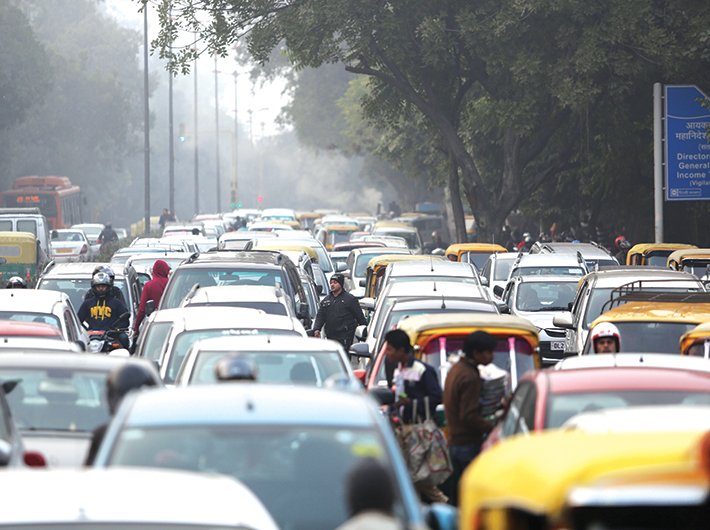It’s a harrowing experience commuting within Delhi-NCR. How can we end this chaos?
An ambulance meekly blares away as scores and scores of vehicles remain stuck, not able to give way to the needy patient even if they wish too. That is a common sight during the rush hours in cities across India that have mushroomed organically, with hundreds of new cars coming out on roads that were planned and built decades ago.
READ: Let common sense prevail
The traffic torture, however, is, multiplied several fold in the national capital region (NCR) which includes Delhi plus the booming satellite townships of Gurgaon, Faridabad, Noida (and its suburbs like Greater Noida), Ghaziabad. It is practically one city, but divided in administration terms, with each civic authority doing things in its way. Put together, NCR is home to more than 2.5 crore people – making it bigger than at least 50 countries. A UN report counts Delhi, that is NCR, as the second largest city, next only to Tokyo, and ahead of Shanghai, Mexico City, Mumbai and São Paulo. Unlike the other 2-crore-plus cities, NCR, however, has different authorities battling the traffic problem differently.
Augmenting public transport, for example, can reduce the traffic woes, but that would need coordination among several authorities. Thus, very little or no integration of public transport in the NCR forces commuters to rely on their own vehicles. Though Delhi Metro offers some respite, the maddening rush during peak hours offers little help. Even the newly-started Delhi-NCR auto-rickshaw service is not providing relief to the commuters. Autos are too few for the ever increasing population.
When Arvind Kejriwal, then a resident of Kaushambi, was elected as the chief minister of Delhi people hoped he would bring some respite to the commuters being aware of the traffic woes of NCR. Yet, very little has been done on this front. Moreover, the promise of Smart Cities as envisioned by PM Narendra Modi looks bleak when the capital city is not able to resolve its gridlock and traffic chaos.
According to a study by the industry body Assocham, a growing number of vehicles on the roads is the major cause for the jams. As per the Economic Survey of Delhi 2014-15, the total number of motor vehicles on road in the capital as on March 31, 2015 was 88.27 lakh, showing an increase of 6.4 percent over the previous year. However, the road network of Delhi has increased from 32,131 lane km in 2007-08 to just 33,198 lane km in 2014-15. Considering the fact that thousands of vehicles are added to the city roads daily, the road network is not expanding at the same rate.
Also, public transport has expanded at a very dismal rate. There were 57 buses for every one lakh Delhiites in the 1980s, but the number has fallen to 25 today, media reports estimate. “There is a huge imbalance between the demand and supply. There has been an increase in travel demand but supply of transport infrastructure is very less. This mismatch is because demand is shooting up at a high rate due to increase in the usage of private vehicles,” says Dr Ashish Verma, president, Transportation Research Group of India (TRG).
Moreover, the poor quality of public transport forces people to rely on private vehicles. “Travelling to Ghaziabad from Noida is a horrible experience. Frequency of state-run buses is low and private buses don’t follow any time-table. No one in the NCR follows traffic rules either. Once it took me two hours to reach a place which is only about 20 km away. The roads are in a pathetic state. Is this the NCR which will be made into a smart city?” questions Swati Mohan, an MNC executive.
Faulty planning
The commuters blame authorities for the gridlock, while authorities feel that half of the traffic problems can be solved if people follow traffic rules. But according to Sanjay Gupta, professor of transport planning at the Delhi-based School of Planning and Architecture (SPA), faulty planning of the city is the crux of the problem. “The city [Delhi] is not being designed around public transport; there are gaps in its planning.
Every master plan, including the current Delhi master plan, doesn’t even have a provision for space where buses can ply,” says Gupta.
Not that public transport service itself is well planned: millions of commuters who depend on public buses to reach office in time every morning have a plethora of complaints about the Delhi Transport Corporation (DTC). The bus does not arrive for half an hour, and then behind one crowded bus there are three empty ones within five minutes. DTC also faced the ire of the National Green Tribunal (NGT) in August for “wasting government revenue”, “creating traffic chaos” and causing “environmental pollution” for running buses without passengers for most of the day due to lack of rationalisation of routes.
Choked lives
Rs.60,000 cr
The country loses every year due to congestion and fuel wastage
Rs.9,944 mn
Worth of fuel Delhi loses annually due to idling of vehicles
6 years
An executive spends in traffic jams in gridlocked Delhi during an average 30-year career
4.5 hours
Delhi and NCR lose a day commuting due to slowdown of buses because of road congestion
Source: TCI, IIM Calcutta, CRRI, Assocham
Gupta says that the transport department of the Delhi government per se does more of administrative jobs and it is not really very thick into the planning, which needs to have a relook. Unlike, say, Transport for London, which focuses thoroughly on planning, the Delhi transportation department just does the administrative job of issuing permits and licences.
When Delhi’s transport authorities have failed to set their own house in order, it would be too much to expect them to coordinate with their counterparts in the neighbouring cities – which in turn would be facing the same problem.
To overcome this problem, Gupta suggests that the states should have an integrated public transport service for the NCR and the revenue thus generated should be shared among them. “NCR should be treated as one entity,” says Gupta. The National Capital Region Transport Corporation (NCTRC), set up in 2013, was constituted on this basis where NCR was treated as one entity. However, the NCRTC has focused more on strengthening the rail transport than the bus transit system. Despite a corpus fund of '100 crore, it remains headless even today.
This example underlines another theme: solutions have been envisaged, and policy proposals have been put forward, and then there is little progress.
On similar lines, a Unified Metropolitan Transport Agency (UMTA) was envisaged in all cities with million-plus population under the National Urban Transport Policy (NUTP), 2006. UMTA was to be like an umbrella body to regulate the overall performance of the public transport system of a city. “Delhi still doesn’t have an UMTA. So the genesis of the problem is that so many people are going their own way and there is no coordination. The Metro is planned by DMRC [Delhi Metro Rail Corporation], road transport by DTC, and they have no linkages. They all work in silos,” says Gupta.
Similarly, a pact envisaging unrestricted movement of inter-state traffic of vehicles registered in the NCR was signed five years back between Delhi and its neighbouring states of Uttar Pradesh, Haryana and Rajasthan. But the reciprocal common transport agreement has still not been fully implemented, and the centre has urged the supreme court to direct all four states to fully implement it.
Unjamming the mess
Experts point out that what Delhi/NCR is facing is not such a unique problem after all. Many developed nations have also faced the same traffic problem which they overcame with policy changes. “The Netherlands faced a similar situation 45 years back. It made a shift in its policy towards providing a mobility solution. It had a strong political will and a people’s movement was started to promote cycling. Around 65 percent of people in Amsterdam now use the bicycle which is not only environment-friendly but also safe,” says Dr Verma.
It is not that the government has not taken any steps to ease the congestion on roads. In the past decade or two, many flyovers and bridges have been constructed in the NCR area. But the situation remains the same. “Such road-based solutions are not enough for the NCR. The demand is growing exponentially and so is the number of private vehicles. The distances are large so people rely on private vehicles. The only way to bring change is by having an extensive network of high capacity public transport system,” says Dr Verma, adding, “Road widening and road-based planning will not help us. We need complementary policies which will promote public transport. This is the long-term solution and cannot happen overnight.”
Agrees Shreya Gadepalli, regional director, Institute for Transportation and Development Policy (ITDP) India: “Any attempt to fulfill this insatiable demand for car-oriented infrastructure – wider roads, flyovers, and parking – is futile. They do not solve the city’s traffic problems. The only solution is better public transport along with stringent measures to control personal motor vehicle use.”
“Land use planning is necessary for traffic management,” says Gupta from SPA. The government should focus on having a mix of land use and transport strategies. For example, in Paris everything is within walking distance from the metro stations. So people use public transport extensively, explains Dr Verma.
But our public transport system doesn’t provide door-to-door connectivity. So we should focus more on providing last mile connectivity and dis-incentivise people from using private vehicles. Public transport should become an attractive choice so that people choose it over personal vehicles, suggests Verma.
Concurs Gadepalli, “Public transport must be designed to capture the imagination of the citizenry and garner their support; it should be designed not just for captive users, but also for those who have the choice of using a personal motor vehicle but are attracted by the quality and efficiency of public transport.”
Developing secondary and tertiary road network can also take care of the peak hour congestion. People commuting to and fro from Noida have the option of using tertiary road networks like the DND and Expressway. But for those in Gurgaon the traffic nightmare is worse. “If you want to enter Delhi from Gurgaon you just have two entry points – NH8 and MG road. Time has come to also look into alternative road networks. We need to have a secondary and tertiary road network policy. Arterial roads are fine, but tertiary roads should be there. These road networks can give more choices to people to move around,” suggests Gupta.
A proposal for managing traffic in Delhi and Gurgaon was pitched in 2005. But, for 10 long years the issue remained in a limbo. Recently, the Haryana government has decided to decongest two major roads that link the two cities – Delhi-Gurgaon Expressway and MG Road.
But policy implementation will take time. Meanwhile, there are so many steps that can reduce the problem, and ease our daily woes.
Companies can provide a shuttle service to their employees and provide them an alternative to private vehicles. Flexible working hours can also be promoted to avoid the rush-hour traffic. Work from home solutions can be used to manage the demand. [see box on pg. 40] “By doing so we will split the demand in time and everybody doesn’t come on roads at the same time,” says Dr Verma.
However, as for long-term and really effective measures, the government has to seriously resolve to tackle the challenge. “Most of traffic management solutions are anti-people. A government comes for five years and a bureaucrat for a limited period. So both of them do things which will give them brownie points in that limited period,” says Dr Verma.
Till then brace yourselves for the bumpy ride!
ridhima@governancenow.com
(The article appears in the November 16-30, 2015 issue)

